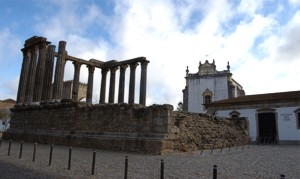 In
the north and west, the finest bulls and horses roam peacefully in lush
fields, and vines, such as those in Cartaxo and Almeirim, are nurtured
gently by the warming sun. In
the north and west, the finest bulls and horses roam peacefully in lush
fields, and vines, such as those in Cartaxo and Almeirim, are nurtured
gently by the warming sun.
This is a land of agricultural traditions and folklore. At the famous Horse Fair in Golega, in November, men dressed in bright 18th century costume put their mounts through demanding haute ecole paces; during the National Agricultural Fair at Santarem in June, you can see flamboyant bullfighting and feel the passionate, frenetic: rhythms of fandango dancing. The Portas do Sol (Gates of the Sun) were once part of Santarem's citadel walls. They open on to wonderful gardens with a panoramic view of the Tagus river snaking below, its banks covered by the famous vineyards of Almeirim, and rich pasture lands in the distance. To the east and south lies a generous countryside of rolling uplands speckled with cork oak, olive trees and grazing sheep. Women tend the fields wearing trousers beneath their skirts and scarves tied around their heads topped with dark hats. Magnificent walled towns
and hilltop forts are legacies from past centuries. For example, mediaeval
Marvao, Monsaraz and the charming spa town of Castelo de Vide, its old
town enclosed within 14th century castle walls. Portalegre is the market
centre of the region, endowed with beautiful manors and white-washed houses.
Its fine ancient tapestries are a flourishing industry, known throughout
the art world.
Evora is a renowned cultural centre and was given world heritage status by UNESCO. Its Roman temple, Moorish alleys and beautiful churches provide an atmospheric setting. Beja lies on the way to the Algarve and has an unhurried old quarter with a serene convent and fanciful castle, while a little further on is Mertola, an important archaeological centre, from whose castle ruins you can behold a sweeping panorama. The wide open spaces of the Planicies are not only to be found inland: all along the coast you can explore long deserted beaches whipped by warm Atlantic winds. Nowhere else can offer such endless and inviting natural beauty. Text provided by the Portuguese Tourism Information Department |
